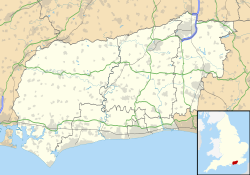| Location | near Findon, West Sussex |
|---|---|
| Coordinates | 50°52′6″N 0°26′48″W / 50.86833°N 0.44667°W |
| OS grid reference | TQ 094 088 |
| History | |
| Periods | Neolithic Bronze Age |
| Designated | 23 February 1933 |
| Reference no. | 1015880 |
Blackpatch is an archaeological site in West Sussex, England, about 2 miles (3.2 km) west of the village of Findon and about 3 miles (4.8 km) north-west of Worthing.
It is the site of a Neolithic flint mine, and Bronze Age barrows. The site is a scheduled monument.[1]
YouTube Encyclopedic
-
1/3Views:110 8677971 941
-
Sussex Ups and Downs (Blackpatch, West Sussex) | FULL EPISODE | Time Team
-
TattooMed Black Patch HOW TO English
-
TattooMed Black Patch HOW TO Deutsch
Transcription
Description
Flint mine
The flint mine, which was levelled about 1950, is on the south-west slope of Blackpatch Hill. There are more than 64 infilled shafts, diameter up to 6 metres (20 ft).[1]
The shafts and other features at the site were investigated from 1922 to 1932 by John Pull. Seven shafts were excavated. They were up to 3 metres (9.8 ft) deep; from them, galleries extended up to 8.5 metres (28 ft), following a single seam of flint. Flint flakes and pottery sherds were found in the infills from the shafts. Around the shafts were working areas where mined flint was processed. An antler pick from a shaft has been radiocarbon dated to about 3000 BC.[1][2][3]
Pull later investigated the flint mines in West Sussex at Church Hill and at Cissbury.[3]
Barrows
The site, now levelled, contained more than 12 round barrows, dating from the Bronze Age. Three of them were over infilled flint mine shafts, with others to the north-east.[1]
References
- ^ a b c d Historic England. "Prehistoric flint mine and part of a round barrow cemetery at Blackpatch, 400m north east of Myrtle Grove Farm (1015880)". National Heritage List for England. Retrieved 24 October 2020.
- ^ "Blackpatch, Findon, West Sussex" Sussex Past. Sussex Archaeological Society. Retrieved 24 October 2020.
- ^ a b "Neolithic flint mines" Bournemouth University. Retrieved 25 October 2020.

